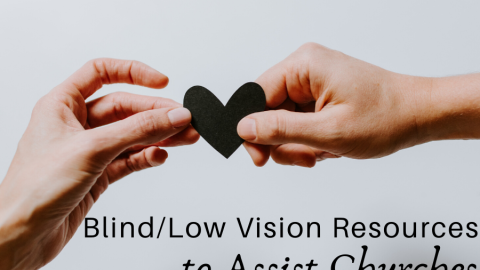This article is part of the series: How to Create Welcoming Spaces for People Who Are Blind or Have Low Vision. We have collaborated with our friends at the RCA on their online platform, Faithward.
-----------------------------------------
As you plan your next meeting or event, ensure that all participants can participate fully and safely. Aim for full inclusivity every time. Find resources here for developing accessible material and documents, hosting an accessible meeting, and creating an inclusive registration.
Note: Even though these suggestions only regard people who are blind or have low vision, event planners should also keep in mind needed accommodations for people with hearing loss and other physical or sensory disabilities.
Providing materials in alternate formats
(Many of these guidelines come from the Accessible Meetings, Events & Conferences Guide)
- If materials have been converted into alternate formats for people who have pre-registered, make sure extras are also available in each format. If there were no requests for alternate formats, or if a meeting does not include pre-registration, materials should at least be available in large print and as accessible electronic files. The National Center on Disability and Access to Education (NCDAE) website provides helpful “cheat sheets” for creating accessible documents in various file formats. (Due to possible changes in technology that occur rapidly, the particular methods of sharing electronic documents may change overtime.)
- Printed materials distributed and used during meetings, including materials used by exhibitors, that have not been converted to alternate formats need to be either read aloud to the whole group or read to individuals who request assistance.
- Sometimes, in spite of great planning, there is last-minute material that cannot be converted into alternate formats. If this happens, designate people to serve as on-site readers. This is a stopgap measure which may work when the meeting is short and there is not a large volume of material to be read. On-site readers can also help participants who are blind or have low vision complete evaluation forms in real time by serving as readers and scribes. Specific skills are needed to be an on-site reader: ability to read material well; a good, clear voice; and, ideally, knowledge of the language and vocabulary used in the documents.
What to do during the meeting
(These tips are provided by the Perkins School for the Blind)
- To help orient attendees who are blind or have low vision to the meeting location, it may be useful to provide some descriptive information. This may include “big picture” information—the layout of the facility and surrounding area, including landmarks and their relation to each other, for example—or information on a smaller scale, such as the location of the coffee pot, telephone, toiletry products, and thermostat in a hotel room.
- It may also help to include specific directions for getting to and from one area of the meeting place to another. In a hotel, for instance, it can be very helpful to provide directions from the lobby, elevators, stairs, or other common “starting points” to specific meeting rooms, restaurants, or other spaces.
- Remove unsafe obstacles. A person who is blind or has low vision can usually navigate safely with a white cane or guide dog, but neither technique can detect 100 percent of potential obstacles. Small objects on the ground (like AV equipment or bags) and objects protruding from the walls (like display cases) can be hazardous. Make sure there’s a barrier-free path into and throughout the meeting room. Also be sure to steady anything wobbly, such as lecterns or microphone stands.
- Introduce yourselves. Ask all participants to introduce or identify themselves at the beginning of the meeting. This lets people who are blind or have low vision know who’s in the room with them. Also, ask people to identify themselves each time they speak during the meeting.
- Describe visual materials. If the meeting will include stand-alone visual presentations like slides, charts, posters, or photographs, make sure the presenter verbally describes them. Usually a brief description will suffice. For example, “The chart shows our sales increased by 77 percent over the last five years.”
- Use multiple methods and formats to communicate any changes in schedules, room assignments, presenters, etc. During general sessions, the following methods can be used to notify participants of changes: email, text message, social media channels, telephone-accessed schedule announcements, voicemail, hotel meeting area video text, sleeping room video text via television, written postings in a designated area, and verbal announcements.
Creating an accessible registration
Your registration form must be accessible to people with disabilities, including individuals who are blind or have low vision and use a screen reader. You can check your online registration form’s accessibility by using a free web accessibility tool, such as WAVE.
Even if pre-registration is optional, strongly encourage pre-registration regardless so appropriate accommodations can be provided.
What do I need to include in a registration form?
“Which formats for materials will help you participate as fully as possible? [choose all that apply]”
- Standard-print hard copies
- Large-print hard copies (18-point typeface)
- Electronic copies in advance (e.g. Word, PowerPoint, Excel)
- Other
- If you selected “Other,” please specify.
Additional resources
Read more from people who are blind or have low vision in the Spring 2020 edition of Breaking Barriers.

Let's Discuss
We love your comments! Thank you for helping us uphold the Community Guidelines to make this an encouraging and respectful community for everyone.